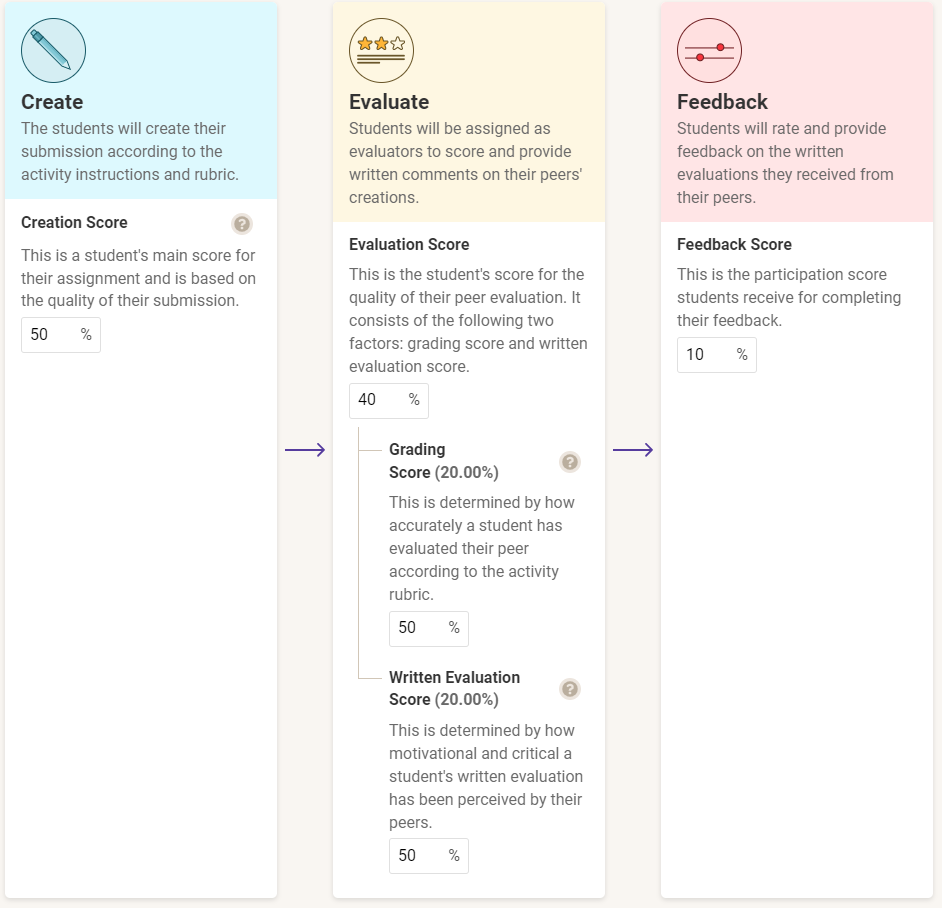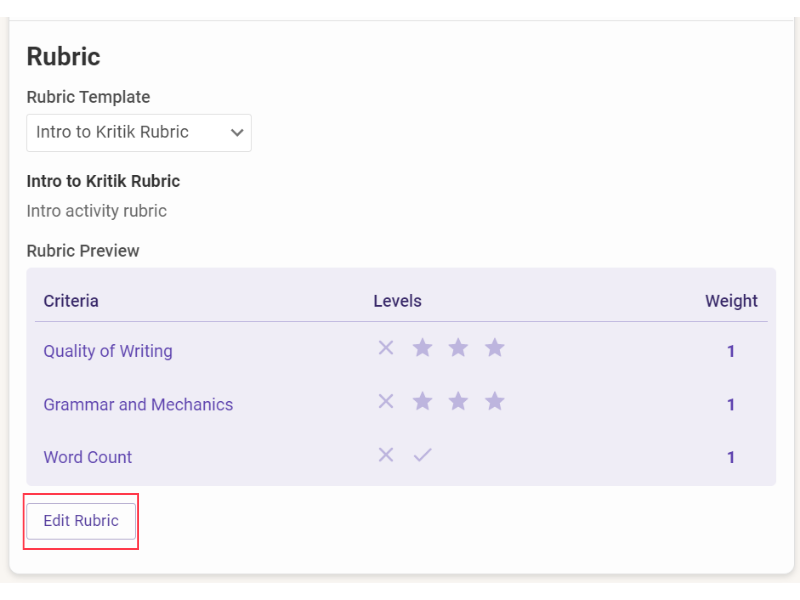Starting your course on the right foot is important for managing students' expectations and setting them up for success. This becomes even more crucial in short-term courses, where students are often required to cram a full semester's worth of content into a condensed schedule. Even though the duration of the course is short, peer assessment can still provide multiple long-term benefits to your students' success when implemented effectively.
With peer evaluation, you are not only creating a collaborative learning environment, but it is a great way to keep students engaged. In this article, we will be covering the following topics:
- Setting up your short-term course on Kritik
- 3 Features on Kritik that you’ll love for your short courses
- 5 Tips to get the most out of your short course on Kritik
Setting up your short-term course on Kritik
The process for setting up your short-term course is similar to when you set it up for your Fall or Winter courses, with just a few minor things that you want to keep in mind. Let us help you get started:
Step 1: Login to your Kritik account

Sign in to your Kritik account by selecting your ‘Country’, and choosing an ‘Instructor’ to proceed to the Instructor Sign-up. Select your ‘Institution’ and finally set up your account information with your ‘Email’ and ‘Password’.
Step 2: Set up your course

Once you are logged into the Kritik platform, you will see a ‘101 - Example Course’, which is an example course with pre-made activities and dummy students. This will give you an idea of how the platform looks and feels. When you are ready to get started, click on the ‘New Course’ box to start filling in the details for your course.
Step 3: Select grading weightage for activities
Once you’ve filled those out, You will eventually reach the page where you get to choose how much the creation, evaluation, and feedback portions of each assignment will be worth.
To maximize the benefits of peer learning, we recommend using a 50%/40%/10% breakdown respectively, to ensure students understand the importance of participating in each stage and stay engaged as a result.

Step 4: Create your first activity
.jpg)
Click on the purple ‘Create Activity’ icon on the top right corner of your screen to select the type of activity you want to set up. Kritik allows you to choose between Individual, Group or Calibration.
Once you have selected the type of activity, you can set the number of evaluations for each student to complete, we recommend 3-5 so they realize the full potential of the peer evaluation process.
Pro Tip: Using the Groups feature is a great way to facilitate effective team-based learning, helping students learn to collaborate at a higher level.
Step 5: Set up your rubric

During the activity set up process, you will be prompted to select the rubric. Providing your students with explicit expectations from the start is important in short-term courses as it helps students be efficient in their approach. We have a number of detailed templates to choose from as well as the ability to create any custom rubric you like.
You can create new custom rubrics for each activity, and manage all of your templates by clicking on the ‘More Actions’ button on the activities page and selecting ‘Manage Rubric Templates’.
.jpg)
Step 6: Schedule your activity

When scheduling your activity for your short-term course on Kritik, ideally you want assessments to have a quick turnaround time. Since students are expecting the workload to be more intense in a condensed course environment, don't be shy in sticking to a concise schedule.
For example, something like a short answer or discussion post could take on a schedule of: 3 days for the creation, 3 days for the evaluation, and 1 day for the feedback on feedback that enables you to complete the activity in a week’s time. There are also options to experiment with late submissions as well as having a grace period.
Step 7: Invite students
.jpg)
Now that you have created and scheduled your first activity, it’s time to start inviting your students by clicking on the ‘Invite Students’ option on the top right corner. Enter your students’ email addresses, separated by a comma and click on ‘Send Invite Emails’. Your students will receive invitations to enroll via email with instructions to access the course.
Step 8: Track progress
.jpg)
Once your students are all enrolled in your course, you are ready to go! Your students will begin completing their Creations, Evaluations, and Feedback according to the schedule and will receive a grade. Kritik allows you to monitor progress of the activity throughout its duration, checking both the completion and scoring in each phase of the assignment. There are also various other filters to use that make this sorting convenient for you.
Step 9: Mark activity as completed
.jpg)
Once students have completed all three phases of the assignment, they will be able to see their overall grade. At this point, the assignment enters a final ‘Grading’ phase which only the professor has access to. This is your chance to resolve any disputes, change grades if necessary, and finally mark the assignment as complete by clicking on the purple ‘Mark as complete’ button above the schedule.
Once an assignment has been marked as complete, student grades are finalized. It is important to ensure you are marking previous activities as completed before the next activity starts, as this will ensure students' grading power is adjusted accordingly to their abilities.
3 Features on Kritik that you’ll love for your short courses
Now that your course is set up on Kritik, we want to introduce you to some features that will help you get the best out of the platform. These features enable you to cover more content in a condensed schedule while also ensuring accurate grades and timely feedback will remain at the forefront.
1. Multi-topic
A multi-topic activity allows instructors to cover a wider range of content by having students do the same activity with varying instructions. For example, each student is assigned one topic to make a creation for in an activity. Half of the class is assigned topic A while the other half is assigned topic B. In the peer evaluation process, students will evaluate creations from the opposite topic instead of their own. This exposes them to a broader range of content in a short period of time, while still ensuring they are required to think critically about their own topic while making their creation, and the other topic while grading their peers' work.
Here’s a quick tutorial on setting up a multi-topic activity.
2. Calibrated Peer Review
.jpg)
Calibration is a key feature of Kritik that aligns student grades to be consistent with the way you would grade as the course facilitator. Calibration activities are especially ideal for short courses since they only have one phase: the Evaluation phase, which means students are not required to upload a creation or feedback.
Pro Tip: Conduct a calibration activity as the first activity in your course so that students begin with a responsible amount of grading power to ensure accurate marks.
Once you upload a completed assignment, and give it the grade you think it deserves based on rubric criteria that you set, your students will then complete their evaluation on the same assignment. Based on how close or far their grades align with yours, they are given a starting point of how much grading power they hold when evaluating their peers.
Once you give them their next assignment, students who scored closely to yours will carry more grading power than their peers who scored differently. Of course, students continue to become better evaluators throughout the semester and their grading power will reflect this.
Here’s a quick tutorial on setting up a calibration activity.
3. Spotlight

The spotlight feature is another great tool to use in short term courses to ensure students receive great feedback in a timely manner. Spotlighted content lives on the Kritik dashboard and appears for both you and your students to see, ensuring all students get timely feedback.
Rather than spending time giving feedback to each student one by one, you have the ability to choose certain well done creations to showcase to your class. You can even spotlight evaluations, by choosing one constructive and one motivational written evaluation from a student and elaborating on why it was a helpful critique.
Here’s how Prof. Alex Gainer from University of Alberta was able to implement peer assessment in the short courses he was teaching.
5 Tips to get the most out of your short course on Kritik
Now that your course is set up and you know about some key features and effective pedagogies to implement in your course, let us equip you with some tips that can help you get the most out of your short-term course and Kritik. Along with implementing peer grading in your classroom, your students will realize and appreciate the benefits of peer learning.
1. Bite-sized activities for peer assessment
For a short-term course, a good rule of thumb is to use bite-sized activities to keep your students engaged without overwhelming them. Things like teaching a peer a new skill, creating a glossary of terms, and simple reflection based activities work well to facilitate this type of learning. By breaking down the creation aspect of the assignment into smaller chunks, students will place a higher emphasis on the evaluation process thus prioritizing the benefits of peer assessment.
2. Duplicate a course

Our course duplication feature makes it easy for you to import content from course to course or from semester to semester. With the click of a button, you can import an entire course or particular activities, including all activity details, rubric information, and calibration. On your activities page, click on the drop down menu under ‘More Actions’ and select ‘Import content’ to duplicate your course.
3. Getting the number of activities right
For a short-term course, roughly one week schedule for each activity would work well in a short-term course. We would recommend 3 as a fair guideline. Of course it depends on how short the course is, but overwhelming your students with weekly Kritik activities is not recommended. Spacing them out bi-weekly will ensure students are more engaged and mitigates any risk of burnout in the process.
4. Managing expectations
Always consider student expectations, and remember that students who register for short-term courses are generally expecting a more intense and condensed workload. Many short-term courses are summer courses, when students likely have a reduced course load and can afford to devote more time to one particular class. These students are keen to learn and want to cover as much as possible in as little time as possible, and Kritik can definitely help expedite this process while also providing multiple pedagogical benefits.
5. Kritik Office Hours
Still have more questions? Attend our virtual office hours! Our team has 4 hours dedicated to helping Kritik professors get the best out of the platform. RSVP here to book a time.
Implement peer assessment the right way with Kritik!
Designing a short-term course that makes the delivery and learning outcomes worth the students time can be achieved with peer assessment. Since the contact hours are lesser compared to a full semester, you can empower your students from the start which keeps them engaged and motivated.
Refer your colleague to Kritik who is running a short course in an upcoming semester and enable them to test out peer assessment before they roll it out to their Fall program.

.jpg)

